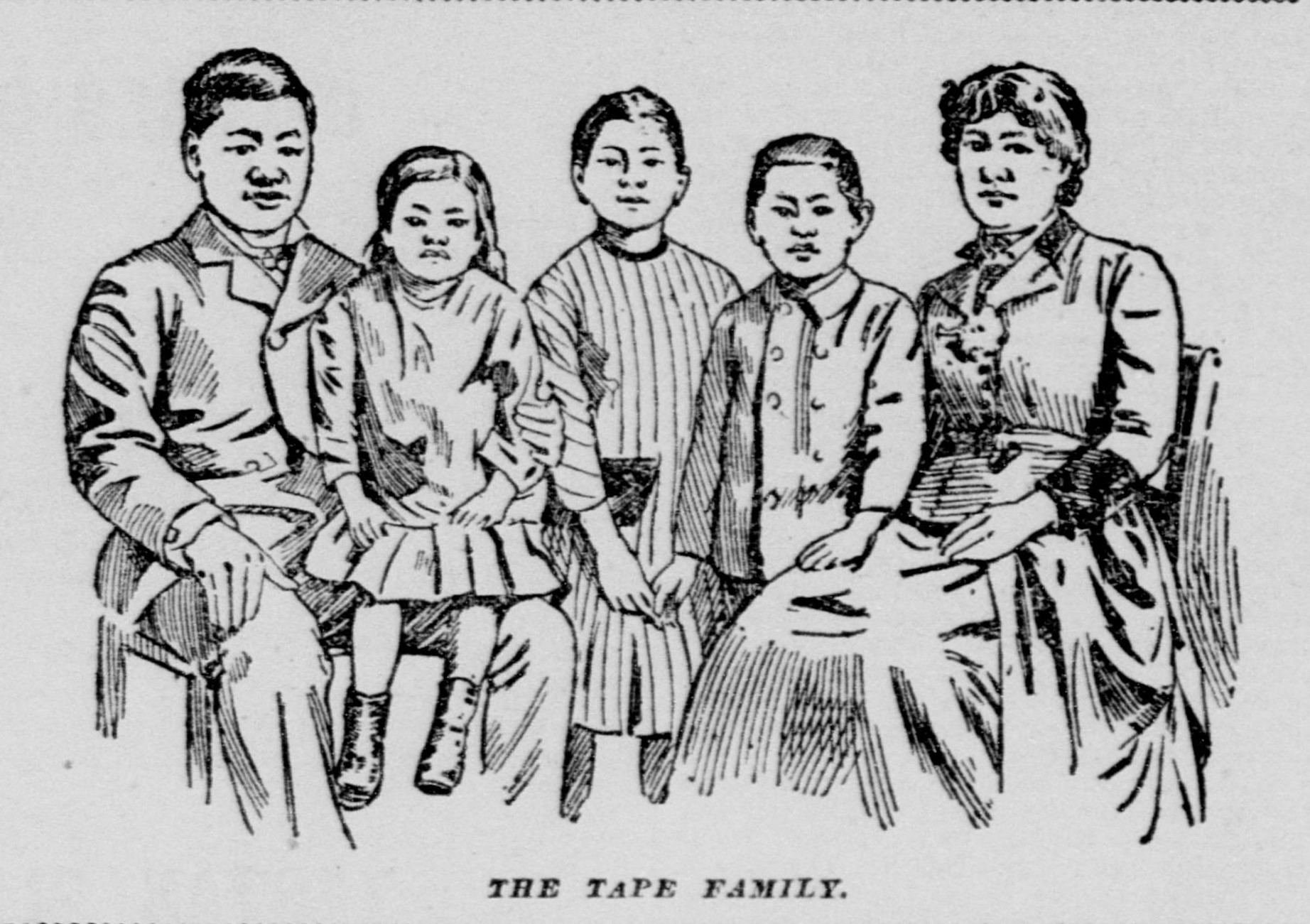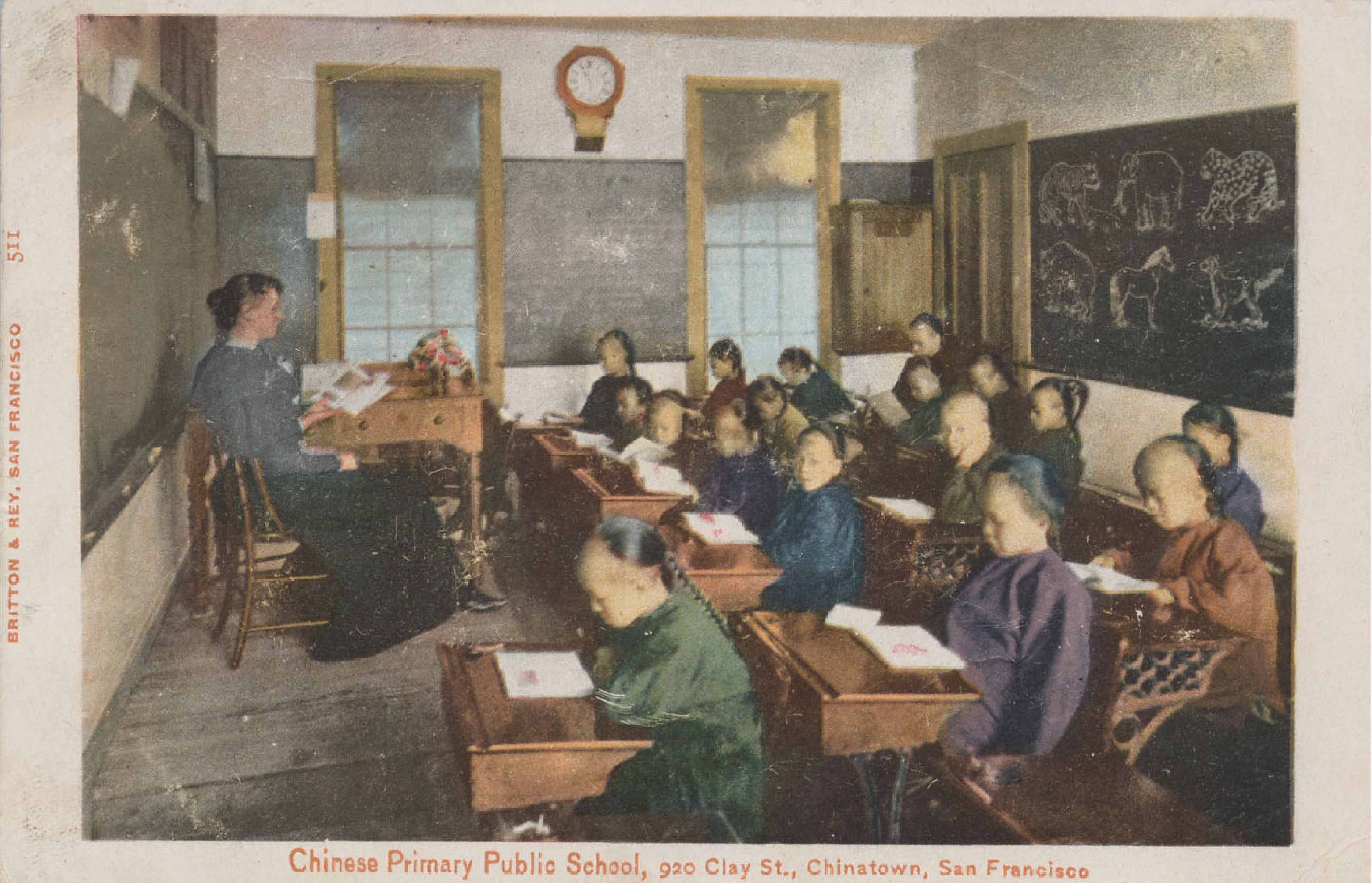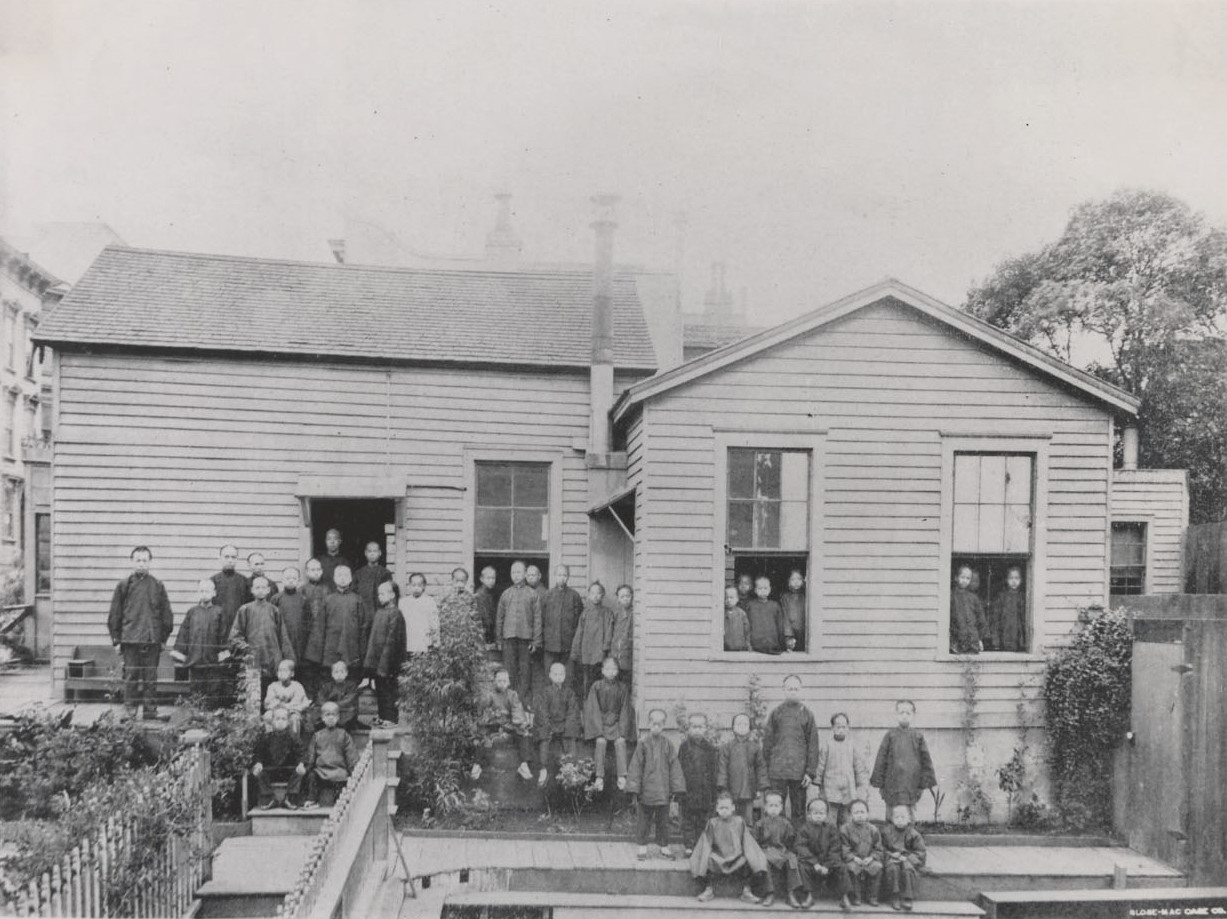1.4.0 - Citizenship and the Right to Public Education
The Asian American Education Project
Grade: 7-10Subject:
U.S. History, Social Studies
Number of Lessons/Activities: 4
In 1884, Joseph and Mary Tape sued the San Francisco School District for the right to public education, arguing that their daughter Mamie Tape deserved the right to attend public school. The California Supreme Court ruled that the Fourteenth Amendment protected the rights of citizens and thus, Mamie, a U.S. citizen, could not be denied the opportunity to attend school. However, the Court ruled that segregated schools were not against the law, which led the San Francisco Board of Education to build separate schools for Chinese students. In this lesson, students will examine how the California Supreme Court Case of Tape v. Hurley (1885) reinforced the Perpetual Foreigner Stereotype. They will analyze a primary source document to understand how this landmark civil rights case set the foundation for ending school segregation.
How did racism and xenophobia enable discrimination against Chinese American students despite the constitutional protections guaranteed to them as U.S. citizens by the court ruling in Tape v. Hurley (1885)?
Students will:
- Analyze a primary source document and examine the extent to which the case of Tape v. Hurley (1885) reinforced the Perpetual Foreigner Stereotype.
Citizenship and the Right to Public Education Essay:
Background:
As anti-Chinese sentiment grew in the United States, Chinese people were excluded not only from immigration but also jobs, certain residential areas of cities, and even schools. Even U.S.-born Chinese people suffered from this exclusion and violence; their citizenship did not provide complete protection against racism or
xenophobia. Having a good education is often associated with gaining upward social and economic mobility and is needed to truly participate in society. As such, the
segregation of schools was one significant avenue through which white society oppressed the Chinese and other people of color. School segregation was a way to maintain power and privilege one group over others.
From 1859 to 1870, The Chinese School served as a public school for Chinese students in San Francisco's Chinatown. Chinese students were legally barred from attending other public schools. In 1870, the law was amended to drop the requirement to educate Chinese children. This led to San Francisco cutting funding for the Chinese School, which shut down. As a result, Chinese parents sent their children to church schools or hired private teachers. In 1884, Joseph and Mary Tape fought back by suing the San Francisco School District. Their case guaranteed the right of children born to Chinese parents to public education. In 1885, the San Francisco School District set up a separate "Oriental School" for Chinese, Korean, and Japanese students. In response to the segregated Chinese School, Mary Tape wrote a letter, arguing for her daughter's right to be educated in her local public school.
Essay:
The Chinese Exclusion Act of 1882 prohibited Chinese laborers from immigrating to the United States. However, Chinese Americans were racially excluded in other ways as well.
In California, the Tape family legally challenged the San Francisco Board of Education after their daughter was denied access to public education. This led to the landmark 1885 California Supreme Court case,
Tape v. Hurley. This case was one of the earliest
civil rights decisions on racist school segregation policies, occurring sixty-nine years before the U.S. Supreme Court deemed school segregation unconstitutional in
Brown v. Board of Education (1954).
Joseph and Mary Tape were Chinese immigrants who came to California in the 1860s. Mary was an orphan and the Ladies’ Protection and Relief Society provided her with housing and taught her English. Joseph worked as a houseboy and a dairyman in his early years, and later became a successful broker. Mary and Joseph saw themselves as American, seeing no difference between them and the native-born Americans they lived amongst in San Francisco. They believed their American-born daughter, Mamie, should be allowed to attend Spring Valley Primary, an all-white school. The principal Jenny Hurley denied Mamie’s enrollment at Spring Valley because of her race. In response to this discrimination, the Tapes sued Hurley, and took the case to the California Supreme Court.
School officials argued that the California Constitution stated that the Chinese were “dangerous to the well-being of the state,” and thus, anyone of Chinese descent should not be admitted to San Francisco public schools. The Tape family argued that their children were entitled to attend public school as a
birthright, expecting them to receive all the rights and privileges of U.S. citizens.
The California Supreme Court ruled that the Fourteenth Amendment protected the rights of citizens and thus, Mamie, a U.S. citizen, could not be denied the opportunity to attend school.
Although Mamie was guaranteed a right to an education as a U.S. citizen, widespread anti-Chinese hate led officials to find a way to discriminate against Mamie nonetheless. The Court ruled that segregated schools were not against the law, which led the San Francisco Board of Education to build separate schools for Chinese students. Later that year, the Tapes had no choice but to enroll their children at the Chinese Primary School but continued to fight for Mamie’s right to attend an integrated school.
Tape v. Hurley ultimately did not win Mamie Tape the ability to attend Spring Valley Primary School or create an integrated school system allowing all students to equitably access education regardless of race. However, this case was an important civil rights decision. Many years later, the federal court case Mendez v. Westminster (1947) and U.S. Supreme Court case Brown v. Board of Education (1954) expanded on the Tape v. Hurley decision that all students should have access to schooling by ruling school segregation on the basis of race was unconstitutional.
Bibiliography:
- Birthright: a particular right of possessions or privilege one has from birth
- Civil Rights: a set of fundamental rights for everyone, including equal treatment under the law, regardless of race, ethnicity, religion, gender, or other personal characteristics
- Segregation: legally separating people by race or ethnicity in an established community within various services and public spaces depending on the law
- Xenophobia: fear and hatred of strangers or foreigners or of anything that is strange or foreign
- Why were schools segregated?
- What were the arguments for and against school segregation?
- Why did the Tape family want to desegregate schools?
- How did racist policies and anti-Chinese sentiments impact the education of Chinese American students?
- Did the Tape family win or not?
- What was significant about the Tape family’s case?
Chinese Primary School on 916 Clay Street in San Francisco, CA. After Tape v. Hurley, Chinese students were given the right to an education, but not with white students.
Credit: “Chinese Primary School, 916 Clay Street, San Francisco (cropped)” by Unknown Photographer, Collection of UC Berkeley, Bancroft Library, Roy D. Graves pictorial collection (San Francisco Views prior to 1906), via Wikimedia Commons (Public Domain)
Activity 1: Introduction to “Separate but Equal”
- Ask students what they think “separate but equal” means. Facilitate a discussion around what this concept means in theory versus practice and whether or not equity can be achieved if enacted.
- Have students work in pairs and list examples of the “separate but equal” concept. Share responses with the whole class.
- NOTE TO TEACHER: An example of an application of “separate but equal” is everyone having access to water fountains but with different fountains for different races.
- Ask students what they know about segregated schools (the separation of students based on their race) and record student responses for all to see.
- NOTE TO TEACHER: This lesson assumes students are already familiar with Brown v. Board of Education (1954). If this is not the case, provide students with a summary of this landmark court case. Optional: Show this PBS video about the case: https://youtu.be/TTGHLdr-iak
- Inform students that this lesson focuses on Tape v. Hurley (1885) which took place sixty-nine years before Brown v. Board of Education (1954).

Drawing of the Tape Family in November 23, 1892’s edition of The Morning Call.
Credit: “The Tape Family,” from The Morning Call, via Library of Congress (Public Domain)
Activity 2: Understanding Tape v. Hurley
- NOTE TO TEACHER: If you have limited classroom time, have students complete the reading as a homework assignment the night before you implement this lesson. This will allow you to focus less on comprehension and more on annotation skills for this lesson.
- Have students read the essay on Tape v. Hurley (see worksheet entitled, “Essay: Citizenship and the Right to Public Education”).
- Read and annotate the background essay as a class. Explain to students that annotating is a way of interacting with the text as you read, a way to slow down to read more closely and mindfully, and a way to keep track of what you’re thinking as you read (what you understand, what is confusing, what stands out).
- Model by reading aloud and annotating the first 2-3 paragraphs in a way that allows students to follow along (share-screen, projector, etc.); Model and direct students to do the following:
- Circle/Highlight key words. (Explain why these words seem important.)
- Put a question mark next to words or ideas that you don’t understand.
- Write down notes and questions in the right column. Write phrases that express reactions and interpretations.
- Write a summary of the gist in the last row. Tell students to use their own words.
- Have students read and annotate the rest of the text by themselves.
- Have students work in small groups and share their notes and questions. Give students the opportunity to address and resolve any of the questions.
- NOTE TO TEACHER: There are many annotation strategies. Feel free to use a strategy that works for you.
- NOTE TO TEACHER: If time permits and if students need more support, watch the video in The Asian American Education Project’s lesson entitled, “The Fight for School Desegregation by Asian Americans”: https://vimeo.com/685562797
- Facilitate a discussion about the essay using the Discussion Questions.
Activity 3: Analyzing Mary Tape’s Letter to the Board of Education
- NOTE TO TEACHER: This lesson assumes students know what a primary source versus secondary source is. If not, take time to define and explain primary sources and secondary sources.
- Distribute Mary Tape’s Letter to the Board of Education and the worksheet entitled, “Document Analysis of Mary Tape’s Letter.” Have students read and analyze the letter by completing the following questions on the worksheet. Explain all the components of the document analysis:
- Identify Section: This section is focused on identifying basic information. This information is often literal and easily found.
- Type of Document: This is asking for format or genre like letter, diary, newspaper, photograph, art, video, etc. Document type helps determine audience and purpose.
- Title: This is asking for the name of the document. Note who created the title; for example, did the author create the title or a newspaper writer? Some documents may not have a title.
- Author(s): This is asking for the creator(s). Note the positionality and identities. Who the creators are matter in regard to perspective, tone, etc.
- Examine Section: This section requires the researcher to make some inferences and use context clues.
- Date Created: This is asking for the time period which determines the historical frame of reference.
- Audience: This is asking for the intended recipient of the document. Knowing the audience helps determine the purpose.
- Message: This is asking for the purpose or meaning.
- Interpret and Analyze Section: This section requires deeper critical analysis in order to determine how this document serves as a historical artifact. The researcher will use all the information from the previous sections to answer this section.
- Analysis: This is asking for the researcher to think about hidden messages and to determine the document’s role in history.
- Historical Context & Significance: This is asking for the researcher to situate the document within its historical setting.
- NOTE TO TEACHER: If students need more support, instead of having them complete in small groups, model how to complete the primary document analysis using Mary Tape’s letter as a class. (See Answer Key.)
- Arrange students in groups of three for small group discussions. Have students analyze how their notes are similar and different, paying close attention to the questions in the “Examine” and “Interpret and Analyze” sections. Direct students to discuss the following questions:
- In what ways were your notes similar?
- In what ways do your notes demonstrate a different understanding of the text?
- How did seeing your group members’ notes change your own reaction to and/or feelings about the text?
- NOTE TO TEACHER: If students need more support understanding the Tape v. Hurley case, have them complete the cause and effect graphic organizer from the lesson “Citizenship and Acts of Exclusion Against the Chinese” of the Citizenship unit.
- Assign students the following task for homework as an assessment: “In one page, explain how the Perpetual Foreigner Stereotype impacted the Tape family’s fight for desegregation.”
- NOTE TO TEACHER: If students need more support understanding the Perpetual Foreigner Stereotype, review the first lesson in the Citizenship unit, “Introducing the Theme of Citizenship in Asian Pacific Islander Desi American (APIDA) History” and/or implement The Asian American Education Project’s lesson entitled, “Perpetual Foreigner - Systemic Racism Against Asian Americans”: https://asianamericanedu.org/perpetualforeigner.html.

Postcard of classroom at the Chinese Primary Public School on 920 Clay St. in Chinatown, San Francisco, CA.
Credit: “Chinese Primary Public School, 920 Clay St, Chinatown, San Francisco” Postcard printed by Britton & Rey, part of the Collection of California Historical Society, via
Wikimedia Commons (Public Domain)
Activity 4: Right to Education
- Have students do a quickwrite given the following prompt: What would you do if your right to an education was taken away from you? Do you agree or disagree with Mary Tape’s actions?
- Facilitate a discussion about student responses.
- NOTE TO TEACHER: If time permits, have students work in pairs and discuss the following prompts: What does it mean to have an educated citizenry? Why is education important to communities of color? In what ways has education been harmful to communities of color? For some, education is the key to upward mobility. For others, education has been used to erase and minimize their cultures and heritages, i.e., Native American boarding schools and the banning of Hawaiian language instruction in schools.
- If you are teaching this lesson as part of the Citizenship unit: Inform students they will be learning about how APIDA communities fought for citizenship in the courts.


